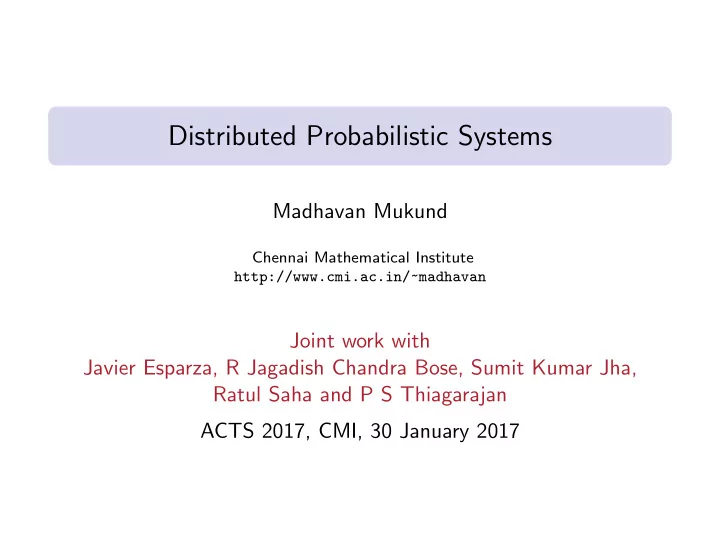

Distributed Probabilistic Systems Madhavan Mukund Chennai Mathematical Institute http://www.cmi.ac.in/~madhavan Joint work with Javier Esparza, R Jagadish Chandra Bose, Sumit Kumar Jha, Ratul Saha and P S Thiagarajan ACTS 2017, CMI, 30 January 2017
Overview Probability is a useful way to model uncertainty Rich theory of probabilistic systems Markov chains, Markov Decision Processes (MDPs) Quantitative analysis Fixed point computations, graph theoretic analysis Statistical methods Add time, costs? Distributed probabilistic models? State explosion due to parallel components Factorize global probabilities via local transitions Synchronizations through actions: MDPs unavoidable
Resource constrained processes A process is a collection of tasks Assembling a car, approving a loan application Tasks have logical, temporal dependencies Some tasks may be independent of each other Tasks are allocated to resources Items of machinery, desk staff Heterogenous resources — the slow immigration counter Cases: Multiple instances of a task Can process in parallel, but contention for resources Arrival pattern
An individual case Loan application
The full story Causality and concurrency — like a Petri net Derive probabilities from past history
The full story . . .
Resource constrained cases
Towards a formal model Tasks and resources are agents Agents interact Task-task causal dependency Allocation of task to a resource Each interaction can have a duration and a cost Typical question C cases arrive at λ cases per second. Do at least x % complete within time t , with probability at least p ?
Probabilistic asynchronous automata Local components { 1 , 2 , . . . , n } , with local states S i For u = { i , j , k , . . . } , S u = S i × S j × S k × · · · Set of distributed actions A Each action a involves subset of agents: loc ( a ) ⊆ { 1 , 2 , . . . , n } Transition relations: ∆ a ⊆ S loc ( a ) × S loc ( a ) With each a event e = ( u , v ), associate a cost χ ( e ) and a delay δ ( e ) For simplicity, delay is a fixed quantity Assign a probability distribution across all a -events ( u , v 1 ) , ( u , v 2 ) , . . . , ( u , v k ) from same source state u
Succinctness advantage Two players each toss a fair coin If the outcome is the same, they toss again If the outcomes are different, the one who tosses Heads wins
Succinctness advantage . . . What if there were k players? k parallel probabilistic moves generate 2 k global moves
Distributed model for coin toss Decompose into local components Coin tosses are local actions, deciding a winner is synchronized action
Resolving non-determinism What is the probability of observing ab ?
Distributed Markov Chains Structural restriction on state spaces, transitions Agent i in local state s i always interacts with a fixed set of partners Previous example violates this Each run is a Mazurkiewicz trace Fix a canonical maximal step interleaving (Foata normal form) Each finite trace has a probability derived from underlying events Combine to form a Markov chain Though restricted, can model distributed protocols like leader election
Distributed Probabilistic Systems Alternatively, work with schedulers Traditional MDP analysis analyzes best-case or worst-case behaviour across all possible schedulers In applications such as business processes, schedulers are typically simple Round-robin Priority based . . . Fix such a scheduling strategy and analyze
Defining schedulers At each global state u , some set of actions en ( u ) is enabled A subset of actions is schedulable if the participating agents are pairwise disjoint Without delays on events, can define a global scheduler and execute maximal steps With delays, steps end at different time points Scheduler should make decision at each relevant time point respecting concurrency
Snapshots A snapshot ( s , U , X ) is a global state with information about events in progress s is a global state U is a set of actions currently in progrews X has an entry ( a , e , t ) for each a ∈ U , where e is the event probabilistically chosen for a t is the time left for e to complete—recall that e has associated delay δ ( e ) Events in X can be sorted by finishing time Choose the subset Y that will finish earliest, say in time t ′ Update ( s , U , X ) accordingly Reduce time for all unfinished events in X by t ′
Schedulers and snapshots Scheduler has to choose a subset of en ( s ) at each snapshot ( s , U , X ) Choice should respect concurrency State is updated only when an event completes Actions in progress, U , must continue to be scheduled Demand that scheduler chooses a subset of en ( s ) that includes all of U Claim Under such a scheduler, a distributed probabilistic system describes a Markov Chain
Analysis Typical question C cases arrive at λ cases per second. Do at least x % complete within time t , with probability at least p ? Statistical model checking Simulate system and check fraction of runs that meet the requirement Statistical probabilistic ratio test (SPRT) determines number of simulations required to validate property within a desired confidence bound
Experiments The loan processing example Fixed time bound Fixed number of cases
Extensions Stochastic delays Analysis based on cost and time Structural reduction rules (a la negotiations) More sophisticated analysis of schedulers . . .
References Distributed Markov Chains R Saha, J Esparza, S K Jha, M Mukund and P S Thiagarajan Proc. VMCAI 2015 , Springer LNCS 8931 (2015) 117–134. Time-bounded Statistical Analysis of Resource-constrained Business Processes with Distributed Probabilistic Systems R Saha, M Mukund and R P J C Bose Proc. SETTA 2016 , Springer LNCS 9984 (2016) 297–314
Recommend
More recommend